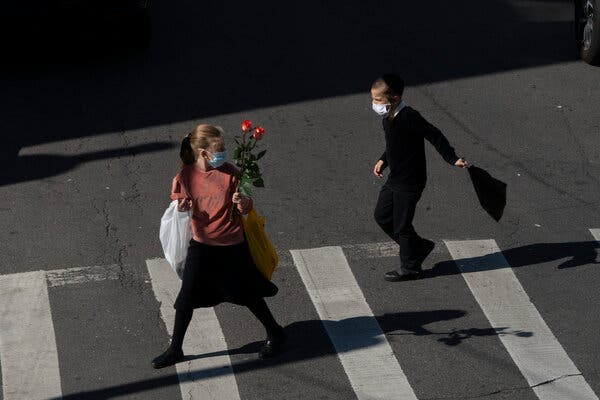Weather: Rain is likely with patchy fog. Expect a high in the mid-60s. Partly cloudy tonight.
Alternate-side parking: In effect until Nov. 1 (All Saints Day).
New York is at a critical point. Even as city and state coronavirus positivity rates declined over the summer, officials have been wary of what the fall may bring.
High positivity rates have cropped up in “hot spot” neighborhoods and hospitalizations have increased as well. Tensions have also risen, especially in Orthodox Jewish communities where residents have protested against new city and state restrictions.
Here’s the latest:
What does the data show?
Gov. Andrew M. Cuomo and Mayor Bill de Blasio have raised concerns about rising cases in parts of Brooklyn and Queens, particularly in communities with large Orthodox Jewish populations.
Daily positivity rates in parts of the Borough Park neighborhood of Brooklyn had exceeded 8 percent. The rate in nearby Gravesend was higher than 7 percent. Brooklyn neighborhoods without large Orthodox populations have experienced high rates as well, like Fort Greene, Bedford-Stuyvesant and Clinton Hill.
The overall state positivity rate hovers at about 1 percent, while the positivity rate in hot spots had been at about 5 percent. On Monday, the test positivity rate for “red zone” areas — or those with the highest infection rates — was 3.7 percent, the governor said.
How did the governor and mayor respond?
With a public tug-of-war. After Mr. de Blasio announced he’d close nonessential businesses and schools in hot spot neighborhoods, Mr. Cuomo halted the mayor’s plan and came up with his own.
Schools were closed a day earlier, and color-coded maps showed what types of restrictions applied to parts of Brooklyn and Queens. Capacity at houses of worship in red zones were limited to 10 people at a time.
This led to confused restaurateurs, business owners and parents of students who weren’t sure which restrictions applied to them. The plans also drew backlash from Orthodox Jewish residents who felt targeted.
How did communities respond?
Despite lawsuits, two separate judges allowed Mr. Cuomo’s plan to place restrictions on houses of worship.
The restrictions led to protests in Borough Park, where demonstrators, mostly Orthodox Jewish men, lit fires and burned masks. The protesters attacked at least three people, including Jacob Kornbluh, a well-known Jewish journalist.
Heshy Tischler, a talk radio personality and one of the men who organized the protests, was arrested Sunday and charged with inciting a riot and false imprisonment in connection to the attack on Mr. Kornbluh.
Is this the start of a second wave?
Not necessarily. So far, there’s no evidence of another wave, Dr. Wafaa El-Sadr told my colleague J. David Goodman.
There are two things to keep an eye on: an increase in cases per day and an increase in hospitalizations. On both of those fronts, the data doesn’t look promising.
In the city, the one-week average of new positive cases was 556 on Oct. 6, compared with about 340 in mid-September. Statewide, hospitalizations have consistently risen in recent days, from 636 on Oct. 5 to 878 as of Monday.
Still, a second wave is difficult to predict.
“No one signal tells you everything you need to know,” said Dr. Jennifer Nuzzo, an epidemiologist.
From The Times
Rep. Max Rose Seeks 2nd Term by Targeting Fellow Democrat: De Blasio
New Prize Modeled on MacArthur ‘Genius’ Grants Hands Out $1 Million
Chinatown Museum Gets $3 Million After Fire Threatens Its Archives
David Hasselhoff and Cheetos: Pandemic Art Goes ’80s
Carol Paumgarten, ‘Den Mother’ to a Dance Scene, Dies at 76
Want more news? Check out our full coverage.
The Mini Crossword: Here is today’s puzzle.
What we’re reading
More families want to teach their children from home, but home-schooling requests have been delayed. [New York Post]
City residents created a petition to name part of St. Marks Place after punk icon Jimmy Webb. [Bowery Boogie]
After almost 100 years, the Roosevelt Hotel will close because of the coronavirus pandemic. [CNN]
And finally: The show must go on
Michael Paulson writes:
The Park Avenue Armory’s vast drill hall has nearly 40,000 square feet of unobstructed open area. The Shed’s central performance space has a 115-foot-high ceiling. St. Ann’s Warehouse has 10 big double doors and a new air ionization system.
While the pandemic-prompted closing of Broadway is expected to drag into next summer or fall, performing arts organizations argue that their futures need not wait that long.
The coalition, which also includes BRIC, Harlem Stage, National Black Theater, and the still-under-construction Perelman Center, is pressing Governor Cuomo to permit performances for small masked audiences.
Their venues all have flexible seating, which they say makes social distancing more feasible. Additionally, these institutions are nonprofits, so they don’t need to cover production costs with ticket sales.
[Learn more about the coalition’s efforts here.]
“We need to start breathing life back into this carcass that is our industry,” said Alex Poots, artistic director and chief executive of the Shed, a cultural center that opened last year in the new Hudson Yards development on Manhattan’s West Side.
“We all know that theater, music, and the performing arts are dying on their feet right now,” Mr. Poots said, “and if we can find a safe way of getting back to work, surely that has to be taken seriously.”
One sign of good will: The state quietly declared recently that its guidelines allow flexible multidisciplinary spaces to be legally used for activities like rehearsals (now underway at the Armory), gallery exhibits (opening this week at the Shed), and film production. But the holy grail — ticketed events featuring live performers — remains out of reach, so far.
It’s Tuesday — take a bow.
Metropolitan Diary: Game on
Dear Diary:
When I was a teenager growing up on Long Island, I spent several summers as a camp counselor in Vermont.
My best camp friend was a guy from Boston named Gus. We played this silly game all summer: One of us would sneak up on the other, slap him on the back, yell “gotcha last” and run away.
On the last day of my last summer at camp, I was climbing up the stairs of one of the buses when I felt a smack on the back and heard Gus scream, “Gotcha last!” The game was over and I had lost.
Seven or eight years later, I was working in Midtown. I walked past the public library one afternoon and looked over to see Gus talking with a group of people on the steps.
I had a very important decision to make. And having become a mature adult, I made the sensible choice.
I sneaked up behind him, hit him on the back, shouted, “Gotcha last!” and ran down Fifth Avenue.
— Barry Stone
New York Today is published weekdays around 6 a.m. Sign up here to get it by email. You can also find it at nytoday.com.
We’re experimenting with the format of New York Today. What would you like to see more (or less) of? Post a comment or email us: [email protected].



















